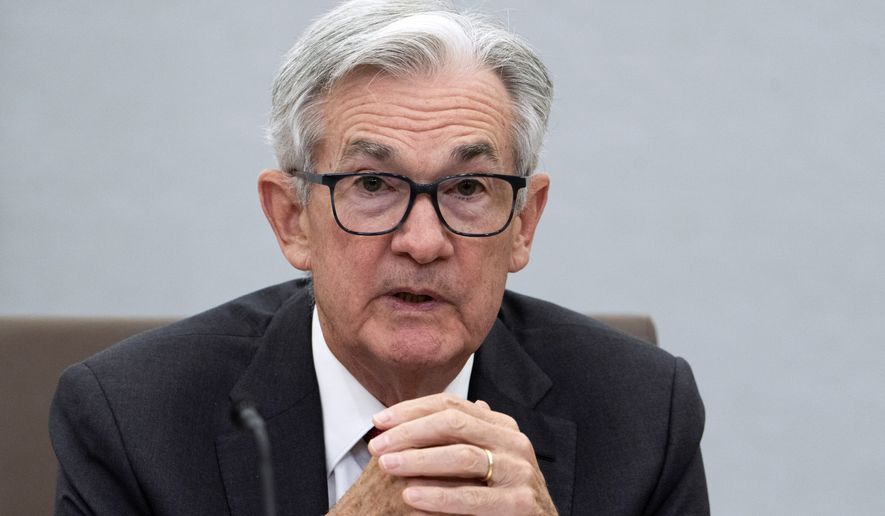OPINION:
The Federal Reserve is not doing enough to fight inflation.
The pandemic, trade war and COVID-19 shutdowns in China and the fallout from the Russian invasion of Ukraine magnify forces that have been building for years.
Zooming, other collaborative technologies and working from home are leaving offices, restaurants and other service establishments half empty on business days. Urban zoning codes and shortages of buildable suburban land, construction materials and skilled labor are combining to drive up rents and suburban home prices.
Western businesses are finding China a less attractive destination for manufacturing and investment. In part, this owes to President Donald Trump’s tariffs that are now sustained by President Biden, President Xi’s anti-business machinations and clumsy COVID-19 response and the looming risks posed by China’s real estate and financing bubbles.
Official data shows foreign investment in the Middle Kingdom rising, but a lot of that is domestic money round-tripping through Hong Kong to better access capital markets and shield investors from mainland policies. Also, Chinese manufacturers are pouring into Mexico, but costs and logistics are more difficult there.
Those and other diversifications of global supply chains instigated by COVID-19 bottlenecks are curbing the downward pressures on prices and wages afforded by more open trade over the last several decades.
Even absent the war in Ukraine, climate change and attendant droughts in North America, China and Europe would curtail agricultural production, hydropower and commercial river transportation.
The most striking characteristic of labor markets is not low unemployment but rather the mismatch between the skills the unemployed offer and what businesses need. Consequently, as the unemployment rate has declined, the ratio of jobs offered to job-seekers has hovered at historic highs and critically, unemployment will have to ratchet up to at least 6.5% to adequately curb wage-price inflation.
Among the largest oil producers, Iran is not likely to be unlocked by a new nuclear deal, and Russia’s resources are not likely to be freed up by an end to the war in Ukraine. Mr. Biden has severely aggravated relations with Saudi Arabia and virtually shut down leasing on federal lands.
On the demand side, Mr. Biden’s pandemic relief and infrastructure packages, the CHIPS Act and student loan debt forgiveness are adding about $3.3 trillion in new spending power.
Since the month before the pandemic began, retail sales are up 30% — 8% after adjusting for inflation. That far exceeds the capacity of the economy to produce more goods and services.
In August, the headline CPI was up 8.3% — off its post-pandemic high of 9% in June. Almost all the pullback was caused by a moderation in gasoline prices that won’t be permanent. Mr. Biden has been pumping record amounts of oil from the Strategic Petroleum Reserve to get him through the midterm elections, and that is a finite resource.
And now for the bad news.
The trend in all measures of core inflation — those that strip out volatile food, energy and sometimes items like used cars — has been heading inexorably north, to more than 6%, and shows no signs of peaking.
Against all this, Federal Reserve Chairman Jerome Powell’s policy responses are just not enough. Since February, he has lifted the federal funds rate by about 3 percentage points.
After taking the helm at the Fed in August 1979, Paul Volcker raised the federal funds rate 6.7 percentage points in eight months.
Yet Mr. Powell’s economy is beset by more structural problems. Both men faced troubling conditions in oil markets, but Presidents Carter and Reagan were looking to enable domestic production, not shut down drilling on federal lands.
Messrs. Carter and Reagan were deregulating to lower business costs and boost competition, whereas Mr. Biden is going in the reverse direction. Add to these climate change and the shift to green energy, working from home, labor market mismatches and the like, and Mr. Powell should be raising rates much more aggressively.
Also, with $3 trillion sitting in household and nonprofit savings and checking accounts from excessive pandemic spending and Mr. Biden’s other profligate fiscal policies, raising interest rates and running down the Fed balance sheet are not having a huge impact outside the housing market.
The banks are losing deposits as households, nonprofits and businesses shift back into money market funds and bonds. But consumers still feel richer and can keep on spending. Banks remain burdened by more deposits than they need to fund their loans books.
Facing a charging wild boar, Mr. Powell has eschewed his big rifle for a pea shooter.
After Mr. Volcker’s initial volleys of rate increases, the U.S. economy slipped into recession in early 1980. He pulled back on interest rates but once the economy was on the mend, he really got religion and raised the federal funds rate to 19% in early 1981.
Mr. Powell needs that kind of conversion experience now.
• Peter Morici is an economist and emeritus business professor at the University of Maryland, and a national columnist.




Please read our comment policy before commenting.